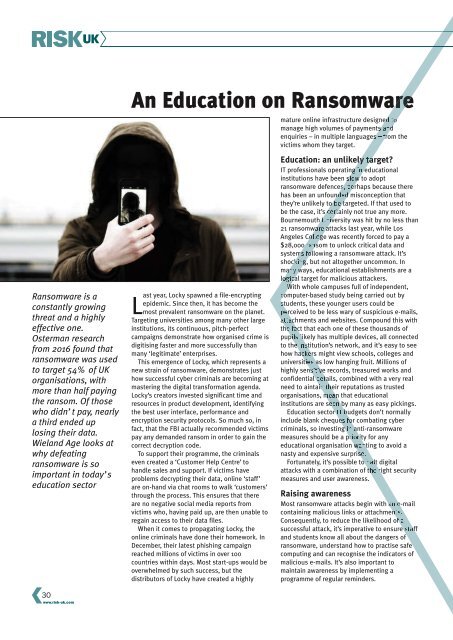RiskUKApril2017
Create successful ePaper yourself
Turn your PDF publications into a flip-book with our unique Google optimized e-Paper software.
Ransomware is a<br />
constantly growing<br />
threat and a highly<br />
effective one.<br />
Osterman research<br />
from 2016 found that<br />
ransomware was used<br />
to target 54% of UK<br />
organisations, with<br />
more than half paying<br />
the ransom. Of those<br />
who didn’t pay, nearly<br />
a third ended up<br />
losing their data.<br />
Wieland Age looks at<br />
why defeating<br />
ransomware is so<br />
important in today’s<br />
education sector<br />
An Education on Ransomware<br />
Last year, Locky spawned a file-encrypting<br />
epidemic. Since then, it has become the<br />
most prevalent ransomware on the planet.<br />
Targeting universities among many other large<br />
institutions, its continuous, pitch-perfect<br />
campaigns demonstrate how organised crime is<br />
digitising faster and more successfully than<br />
many ‘legitimate’ enterprises.<br />
This emergence of Locky, which represents a<br />
new strain of ransomware, demonstrates just<br />
how successful cyber criminals are becoming at<br />
mastering the digital transformation agenda.<br />
Locky’s creators invested significant time and<br />
resources in product development, identifying<br />
the best user interface, performance and<br />
encryption security protocols. So much so, in<br />
fact, that the FBI actually recommended victims<br />
pay any demanded ransom in order to gain the<br />
correct decryption code.<br />
To support their programme, the criminals<br />
even created a ‘Customer Help Centre’ to<br />
handle sales and support. If victims have<br />
problems decrypting their data, online ‘staff’<br />
are on-hand via chat rooms to walk ‘customers’<br />
through the process. This ensures that there<br />
are no negative social media reports from<br />
victims who, having paid up, are then unable to<br />
regain access to their data files.<br />
When it comes to propagating Locky, the<br />
online criminals have done their homework. In<br />
December, their latest phishing campaign<br />
reached millions of victims in over 100<br />
countries within days. Most start-ups would be<br />
overwhelmed by such success, but the<br />
distributors of Locky have created a highly<br />
mature online infrastructure designed to<br />
manage high volumes of payments and<br />
enquiries – in multiple languages – from the<br />
victims whom they target.<br />
Education: an unlikely target?<br />
IT professionals operating in educational<br />
institutions have been slow to adopt<br />
ransomware defences, perhaps because there<br />
has been an unfounded misconception that<br />
they’re unlikely to be targeted. If that used to<br />
be the case, it’s certainly not true any more.<br />
Bournemouth University was hit by no less than<br />
21 ransomware attacks last year, while Los<br />
Angeles College was recently forced to pay a<br />
$28,000 ransom to unlock critical data and<br />
systems following a ransomware attack. It’s<br />
shocking, but not altogether uncommon. In<br />
many ways, educational establishments are a<br />
logical target for malicious attackers.<br />
With whole campuses full of independent,<br />
computer-based study being carried out by<br />
students, these younger users could be<br />
perceived to be less wary of suspicious e-mails,<br />
attachments and websites. Compound this with<br />
the fact that each one of these thousands of<br />
pupils likely has multiple devices, all connected<br />
to the institution’s network, and it’s easy to see<br />
how hackers might view schools, colleges and<br />
universities as low hanging fruit. Millions of<br />
highly sensitive records, treasured works and<br />
confidential details, combined with a very real<br />
need to aintain their reputations as trusted<br />
organisations, mean that educational<br />
institutions are seen by many as easy pickings.<br />
Education sector IT budgets don’t normally<br />
include blank cheques for combating cyber<br />
criminals, so investing in anti-ransomware<br />
measures should be a priority for any<br />
educational organisation wanting to avoid a<br />
nasty and expensive surprise.<br />
Fortunately, it’s possible to halt digital<br />
attacks with a combination of the right security<br />
measures and user awareness.<br />
Raising awareness<br />
Most ransomware attacks begin with an e-mail<br />
containing malicious links or attachments.<br />
Consequently, to reduce the likelihood of a<br />
successful attack, it’s imperative to ensure staff<br />
and students know all about the dangers of<br />
ransomware, understand how to practise safe<br />
computing and can recognise the indicators of<br />
malicious e-mails. It’s also important to<br />
maintain awareness by implementing a<br />
programme of regular reminders.<br />
30<br />
www.risk-uk.com

















